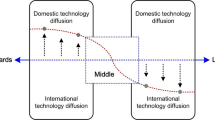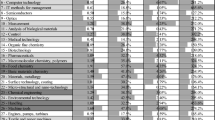Abstract
Concerns regarding the high level of research and development (R&D) expenditure on military technology have prompted many nations to pursue a dual-use regime in military R&D. However, the value of dual-use military technology has not yet been quantitatively investigated. We explore whether military technology with a higher level of duality has been more valuable than that with a lower level of duality. We assume that the patent of valuable military technology was renewed until its termination. We retrieve military patents from the United States Patent and Trademark Office during 1976–2014 based on their International Patent Classification (IPC) as F41 or F42. Then, we propose three indicators to assess the duality level of them. The first indicator is based on the determination of whether the patented technology is utilizable in both the military and the civilian sectors using its IPC. For the second indicator, we estimate the potential of convergence of a patented technology with various technological fields using the degree of centrality of the IPC’s co-occurrence network. The third indicator is based on ratio of forward citation by the civilian sector over the total number of forward citations as a measurement of technology diffusion toward the civilian sector. Using logistic regression, we found that the first two indicators are positively associated with patent renewal decision, while the last indicator is nonsignificant. The effects of the two significant indicators suggests that military technologies are more valuable when the technology itself can be used in various sectors, including the civilian sector, and can be converged with technologies in different fields. However, the nonsignificant influence of the third variable suggests that the relation between patent value and diffusion effects toward following inventions is not confined to the civilian sector. Our findings provide evidence of the impact of dual-use policies in military R&D.



Similar content being viewed by others
Notes
Although dual-use technology includes bilateral technology spillovers between the military sector and the civilian sector, most studies have considered the spillover from the military sector to the civilian sector as dual-use technology. Thus, this paper also focuses on the technology spillover from the defense industry to the civilian industry as dual-use technology.
Maintenance fees are required three times during the life of a patent: at 3–4, 7 –8 , and 11–12 years after the date of issue.
Among collaborated patents, five technologies were developed by Germany and France. For US applicants, 5 patents were developed through joint endeavors with ones in Argentina, Canada, Germany, the UK, and Sweden. The other four patents were applied for by France and Sweden; France and Belgium; the Netherlands and Germany; and the Netherlands and Liechtenstein.
F42B: EXPLOSIVE CHARGES, e.g., FOR BLASTING; FIREWORKS; AMMUNITION.
F41I, F41 N, F41S, F41 V, F42E, F42L, and F42S are not found in IPC codes published by the World Intellectual Property Organization (WIPO). Thus, we consider that 11 military patents that are associated with these IPCs contain typos in their documents.
Among them, 512 patents have no forward citation. Because CIVIL_FCR measures the impact on the civilian sector, we consider that a patent with no forward citation has no impact on the civilian sector.
In Harhoff et al.’s (2003) study, the full model result shows that the coefficient value of the scope of the patent is −0.150 **(p value = 0.084).
In Fischer and Leidinger’s (2014) study, the result of an OLS regression on the price of all sold patents shows that the coefficient value of the scope of the patent is −0.45 (p value = 0.057).
References
Acosta, M., Coronado, D., Marín, R., & Prats, P. (2013). Factors affecting the diffusion of patented military technology in the field of weapons and ammunition. Scientometrics, 94, 1–22.
Ahuja, G., & Lampert, M. C. (2001). Entrepreneurship in the large corporation: A longitudinal study of how established firms create breakthrough inventions. Strategic Management Journal, 22, 521–543.
Alic, J. A. (1994). The dual use of technology: Concepts and policies. Technology in Society, 16, 155–172.
Alptekin, A., & Levine, P. (2012). Military expenditure and economic growth: A meta-analysis. European Journal of Political Economy, 28, 636–650.
Baudry, M., & Dumont, B. (2006). Patent renewals as options: improving the mechanism for weeding out lousy patents. Review of Industrial Organization, 28, 41–62.
Bessen, J. (2008). The value of US patents by owner and patent characteristics. Research Policy, 37, 932–945.
Bojnec, Š. (2016). Dual-use products export multipliers with the indirect effects. Technological Forecasting and Social Change, 102, 287–296.
Burke, P. F., & Reitzig, M. (2007). Measuring patent assessment quality—analyzing the degree and kind of (in) consistency in patent offices’ decision making. Research Policy, 36(9), 1404–1430.
Chu, A. C., & Lai, C. C. (2012). On the growth and welfare effects of defense R&D. Journal of Public Economic Theory, 14, 473–492.
Cowan, R., & Foray, D. (1995). Quandaries in the economics of dual technologies and spillovers from military to civilian research and development. Research Policy, 24, 851–868.
Dumais, S. T. (1991). Improving the retrieval of information from external sources. Behavior Research Methods, Instruments, & Computers, 23, 229–236.
Dunne, J. P., & Braddon, D. (2008). Economic Impact of Military R&D. Brussels: Flemish Peace Institute.
Dunne, J. P., & Tian, N. (2015). Military expenditure, economic growth and heterogeneity. Defence and Peace Economics, 26, 15–31.
Enger, S. (2013). Dual-Use Technology and Defence–Civilian Spillovers: Evidence from the Norwegian Defence Industry. Master’s Thesis. Retrieved from https://www.duo.uio.no/bitstream/handle/10852/35932/Engerx-xMaster.pdf?sequence=1.
Fischer, T., & Leidinger, J. (2014). Testing patent value indicators on directly observed patent value—An empirical analysis of Ocean Tomo patent auctions. Research Policy, 43, 519–529.
Goel, R. K., Payne, J. E., & Ram, R. (2008). R&D expenditures and US economic growth: A disaggregated approach. Journal of Policy Modeling, 30, 237–250.
Grimaldi, M., Cricelli, L., Di Giovanni, M., & Rogo, F. (2015). The patent portfolio value analysis: A new framework to leverage patent information for strategic technology planning. Technological Forecasting and Social Change, 94, 286–302.
Grönqvist, C. (2009). The private value of patents by patent characteristics: evidence from Finland. The Journal of Technology Transfer, 34, 159–168.
Hall, B. H., Jaffe, A., & Trajtenberg, M. (2005). Market value and patent citations. RAND Journal of Economics, 36(1), 16–38.
Han, E. J., & Sohn, S. Y. (2016). Technological convergence in standards for information and communication technologies. Technological Forecasting and Social Change, 106, 1–10.
Harhoff, D., Scherer, F. M., & Vopel, K. (2003). Citations, family size, opposition and the value of patent rights. Research Policy, 32, 1343–1363.
Jee, S. J., & Sohn, S. Y. (2015). Patent network based conjoint analysis for wearable device. Technological Forecasting and Social Change, 101, 338–346.
Ju, Y., & Sohn, S. Y. (2015). Identifying patterns in rare earth element patents based on text and data mining. Scientometrics, 102(1), 389–410.
Kintsch, W. (1998). Comprehension: A paradigm for cognition. Cambridge: Cambridge University Press.
Lanjouw, J. O., Pakes, A., & Putnam, J. (1998). How to count patents and value intellectual property: The uses of patent renewal and application data. The Journal of Industrial Economics, 46, 405–432.
Lanjouw, J. O., Schankerman, M. (1997). Stylized facts of patent litigation: Value, scope and ownership (no. w6297). National Bureau of Economic Research.
Lanjouw, J. O., & Schankerman, M. (2004). Patent quality and research productivity: Measuring innovation with multiple indicators. The Economic Journal, 114(495), 441–465.
Lee, Y. G. (2009). What affects a patent’s value? An analysis of variables that affect technological, direct economic, and indirect economic value: An exploratory conceptual approach. Scientometrics, 79(3), 623–633.
Lee, W. S., Han, E. J., & Sohn, S. Y. (2015). Predicting the pattern of technology convergence using big-data technology on large-scale triadic patents. Technological Forecasting and Social Change, 100, 317–329.
Lee, W. J., Lee, W. K., & Sohn, S. Y. (2016). Patent network analysis and quadratic assignment procedures to identify the convergence of robot technologies. PLoS ONE, 11(10), e0165091.
Lee, B. K., & Sohn, S. Y. (2016). Patent portfolio-based indicators to evaluate the commercial benefits of national plant genetic resources. Ecological Indicators, 70, 43–52.
Lerner, J. (1994). The importance of patent scope: An empirical analysis. The RAND Journal of Economics, 25(2), 319–333.
Lichtenberg, F. R. (1995). Economics of defense R&D. Handbook of Defense Economics, 1, 431–457.
Liu, K., Arthurs, J., Cullen, J., & Alexander, R. (2008). Internal sequential innovations: How does interrelatedness affect patent renewal? Research Policy, 37, 946–953.
Lu, W. M., Kweh, Q. L., Nourani, M., & Huang, F. W. (2016). Evaluating the efficiency of dual-use technology development programs from the R&D and socio-economic perspectives. Omega, 62, 82–92.
Marco, A. C. (2007). The dynamics of patent citations. Economics Letters, 94, 290–296.
Molas-Gallart, J. (1997). Which way to go? Defence technology and the diversity of ‘dual-use’ technology transfer. Research Policy, 26, 367–385.
Moore, K. A. (2005). Markman eight years later: Is claim construction more predictable. Lewis & Clark L. Rev., 9, 231.
Mowery, D. C. (2010). Military R&D and innovation. Handbook of the Economics of Innovation, 2, 1219–1256.
Mowery, D. C. (2012). Defense-related R&D as a model for “Grand Challenges” technology policies. Research Policy, 41(10), 1703–1715.
Nathanson, C. E. (1969). The militarization of the American economy. In Corporations and the cold war, pp. 205–235.
Park, H., & Yoon, J. (2014). Assessing coreness and intermediarity of technology sectors using patent co-classification analysis: The case of Korean national R&D. Scientometrics, 98, 853–890.
Pieroni, L. (2009). Military expenditure and economic growth. Defence and peace economics, 20(4), 327–339.
Putnam, J. D. (1996). The value of international patent rights. UMI dissertation services.
Quintana-García, C., & Benavides-Velasco, C. A. (2008). Innovative competence, exploration and exploitation: The influence of technological diversification. Research Policy, 37, 492–507.
Reitzig, M. (2004). Improving patent valuations for management purposes—validating new indicators by analyzing application rationales. Research Policy, 33, 939–957.
Reppy, J. (1999). Dual-use technology: back to the future. Arming the Future: A Defense Industry for the 21st Century (pp. 269–284). New York: ***Council on Foreign Relations Press.
Ruttan, V. W. (2006). Is war necessary for economic growth?: military procurement and technology development. Oxford: Oxford University Press.
Sapsalis, E., de la Potterie, B. V. P., & Navon, R. (2006). Academic versus industry patenting: An in-depth analysis of what determines patent value. Research Policy, 35, 1631–1645.
Seo, S. J., Han, E. J., & Sohn, S. Y. (2015). Trend analysis of academic research and technical development pertaining to gas hydrates. Scientometrics, 105(2), 905–920.
Smit, W. A. (1995). Science, technology, and the military: Relations in transition. In Handbook of science and technology studies, pp 598–626.
Sterzi, V. (2013). Patent quality and ownership: An analysis of UK faculty patenting. Research Policy, 42, 564–576.
Stowsky, J. (2004). Secrets to shield or share? New dilemmas for military R&D policy in the digital age. Research Policy, 33, 257–269.
Te Kulve, H., & Smit, W. A. (2003). Civilian—Military co-operation strategies in developing new technologies. Research Policy, 32, 955–970.
Acknowledgements
This work was supported by National Research Foundation of Korea (NRF) grant funded by the Korea government (MSIP) (2016R1A2A1A05005270).
Author information
Authors and Affiliations
Corresponding author
Rights and permissions
About this article
Cite this article
Lee, B.K., Sohn, S.Y. Exploring the effect of dual use on the value of military technology patents based on the renewal decision. Scientometrics 112, 1203–1227 (2017). https://doi.org/10.1007/s11192-017-2443-6
Received:
Published:
Issue Date:
DOI: https://doi.org/10.1007/s11192-017-2443-6






